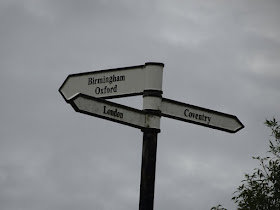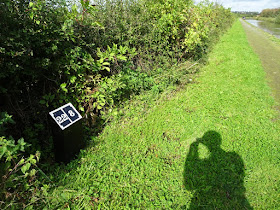Sadly this is the last posting we will make for this year covering the final few days to mid October. We have now left Leo down south and I am typing this update from home in Yorkshire. The last blog update took us through Braunston and up the Leicester Arm of the Grand Union to Yelvertoft. This one continues from there:
 |
| I think we've mentioned before how abundant the tree fruit is this year. This crab apple tree is a good example. |
 |
| We decided on Sunday (13th October) to go up the short Welford Arm to get ourselves a Sunday roast lunch at the Wharf Inn. Sunday started off very wet, so we said our goodbyes to our friend Maurice who had been visiting us and then waited for the rain to stop before setting off. We finally left about 11.30 and this photo shows the mile post where the Welford Arm branches off right. The arm functions as a feeder for water from three reservoirs to the summit level of the Leicester Arm. |
 |
| And the Welford Arm has a lock, albeit only rising about three feet six inches. Above the lock there was a fallen tree but we were lucky that another boat went up the lock before us and we arrived at the fallen tree to find the boat owner cutting away the final branch to let us both through the gap. |
 |
| After a very good meal we walked into Welford which is an attractive village. The view down this road shows a line of thatched cottages, the last three of which are fairly newly built but are still thatched. |
 |
| On Monday the forecast was for rain later so we returned down the Welford Arm in the morning and turned right towards Foxton. This picture shows the first bridge after rejoining the main line of the canal. |
 |
| The forecast was right. We came through Husband's Bosworth Tunnel and moored before we got to Foxton. The rain came on and then slacked off but we decided not to go for a walk and what a good decision that was. The heavens opened so we played Bananagrams and Ian lost twice! The picture was taken the following morning as we prepared to leave and Helen is holding up a new mooring pin which she had carefully cleaned making it 'as clean as a new pin'. |
 |
| On Tuesday morning we soon came to the top of the Foxton Locks. Here 10 narrow locks arranged as two staircases of five locks take the canal down about 75 feet. The picture is taken from the top of the locks. |
 |
| There are lock keepers at Foxton so you need to book in and then they help you down. The flight has side ponds which are in use. You can see a side pond here. Each lock has a red paddle and a white paddle and you first open the red which connects the side pound with the lock below and then you open the white which connects the lock you are in with the side pound, so water pours sideways out of your lock into the side pound to drop the boat down. The rhyme to remember is "red before white, you'll be alright", "white before red, you'll wish you were dead!" It is also 'red before white' going up the flight. |
 |
| Here is Leo in the bottom lock of the top staircase. Below this is a pound where you can pass an ascending boat. Curiously this pound has a circular water current which can cause problems. The lock keeper gave careful instructions on what to expect and rated Ian's crossing of this pound as 9.5 out of 10. |
 |
| Below the flight is a junction where boats can turn right for five and a half miles along a twisty canal arm to Market Harborough, as shown on the sign above. We turned left and carried on towards Leicester, though not without stopping for a coffee while Ian took the toilet cassette to empty at the nearby services. |
 |
| This boat moored opposite to Leo by the pub took our attention. We follow Neil and Karen's blog about life on their boat called Chalkhill Blue II. They previously owned Chalkhill Blue but this was another one - and without the pretty butterfly painted on the side |
 |
| Here is a zoomed photo showing the name. |
 |
| And here for the last blogging photo this year is one of a swan family north of Foxton with the autumn colours becoming apparent. Time to pack up boating and head home to hibernate for the winter. So to the statistics - we have cruised 1,012 miles and passed through 444 locks this year. This represents more miles than we have done for several years but a lower lock total, a feature of the flat lands of the north east waterways where we spent a lot of time early in the year. |
So what are we planning for next year? There's plenty of time to think about it but we shall probably be heading south. We have still not managed to explore all of the Basinstoke Canal because of shortage of water so we would like to give that another try. Thank you to all those who read our blog and we wish you a happy winter.































